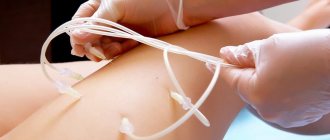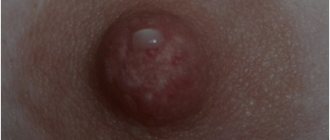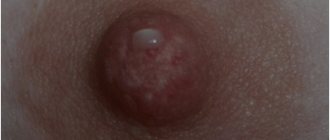Breast asymmetry is a congenital or acquired difference in the volume, shape or location of the breast.
The term breast underdevelopment is sometimes used. Underdevelopment can affect both one gland in relation to another, and individual parts of one gland. Breast tubularity is precisely the underdevelopment of part of the mammary gland. We can distinguish underdevelopment of the lower, upper, lateral and medial slopes. General underdevelopment of this type forms the classic tubular breast: a narrow base and a cylindrical shape of the breast itself.
Asymmetry of the areola or nipples. Areolas can form in different diameters and shapes. The nipples can vary significantly in the degree to which they bulge forward. An extreme case is an inverted nipple or inverted nipples.
Causes of breast asymmetry
- Features of breast development. Developmental features in childhood and adolescence can lead to breast asymmetry. This is probably due to unaccounted for trauma to the mammary gland area.
- Heredity. It can be assumed that breast asymmetry is associated with heredity, but evidence for this has not yet been found.
- Age-related changes . Asymmetry in the process of involution of the mammary glands can increase due to a general decrease in volume, but cannot occur without objective reasons.
- Pregnancy and lactation . Asymmetry appears in the case of “asymmetrical” feeding, when one of the breasts is “used” more and lactates more. This asymmetry subsequently decreases, but does not disappear completely.
- Surgical intervention. Asymmetry can be caused by operations performed in childhood or adolescence in the chest area. Removal of mammary glands, removal of part of the mammary gland, or removal of a tumor are the most common reasons for seeking treatment for asymmetry correction.
- Neoplasms in the breast. Tumor growth can lead to enlargement of one breast. Such tumors can be benign or malignant
- Scoliosis. Curvature of the spine, leading to a lateral tilt of the body and, as a consequence, visual asymmetry of the breast, when one breast looks lower than the other.
Why do breasts come in different sizes?
True asymmetry, when breasts are different sizes and differ from each other by one cup. The reasons can be very diverse. They can be divided into 2 groups.
Congenital causes:
- hypoplasia (delayed development) of glandular tissue
- Poland syndrome is a congenital disease characterized by atrophy of the pectoralis major muscle
- hormonal problems during puberty
- micromastia - one mammary gland is significantly reduced in size compared to the other
- problems with the endocrine system
- prolonged incorrect body position, which leads to poor posture
- hereditary predisposition
- individual feature
Typically, congenital breast asymmetry is noticeable in girls aged 9-10 years. During this period, the ovaries already produce the hormones estrogen and progesterone, which are responsible for the development of glandular tissue. The bust can become disproportionate if hormones are in short supply or excess. If there is disproportionality, then you need to contact an endocrinologist or mammologist. Usually this problem is leveled out by the age of 18-19. If it persists into adulthood, then it can only be corrected by a plastic surgeon.
Acquired reasons:
- Breast-feeding. In this case, breast asymmetry is the so-called post-lactation involution of the mammary gland, which also manifests itself in disproportion. It depends on hormonal changes, and not on the duration of lactation, as many young mothers think. However, asymmetry can actually develop if you feed your baby on only one side.
- Mastopathy (fibroadenomatosis). Benign breast tumor. A characteristic sign of mastopathy is palpable lumps in the breast. The main reason is hormonal imbalance. Often, all types of mastopathy lead to visible asymmetry.
- Neoplasms. After their removal, the breast requires restoration.
- Sagging and drooping breasts. With age, the mammary gland loses elasticity and volume, and the muscles become less elastic. Because of this, the bust loses its former attractiveness and symmetry. This often happens when a woman crosses the threshold of menopause.
- Chest injuries. At risk are female athletes who play basketball, volleyball and other sports where there is a risk of physical injury.
What is correction of breast asymmetry (correction of asymmetry of the breast, mammary glands)?
Breast asymmetry surgery is a procedure that reduces differences between breasts. Minor differences between the breasts are normal, but if these differences cause significant concern, then breast correction is performed.
Depending on the difference between your mammary glands and individual characteristics, there are several correction options:
- enlarge smaller breasts (breast augmentation)
- enlarge or reduce both breasts to varying degrees
- lift sagging breasts (breast lift).
How to get rid of asymmetry
There are several ways to remove asymmetry, but the choice depends on its degree. In addition, for greater effect, the necessary procedures can be carried out separately or in combination. But first you need consultation with specialists, namely a mammologist and a surgeon.
Methods used in practice:
- breast lift (mastopexy);
- silicone implants;
- lipofilling (involves the process of adjusting the breasts using a woman’s own fat; it is used infrequently and with a low degree of asymmetry, as well as if there is no ptosis).
Is breast asymmetry correction right for me?
Surgery to correct breast asymmetry is a highly individual procedure and may not be suitable for everyone. You should always consult your plastic surgeon to make your decision. He will assess your health and create a treatment plan that is suitable for you personally.
Before deciding on surgery to correct breast asymmetry, there are some important questions to keep in mind:
Surgery to correct breast asymmetry will reduce the difference between your breasts at the time of surgery. However, breasts tend to change shape and volume over time, which may require additional correction in the future. The likelihood of having a breast implant replaced is small, but the possibility is present.
Although breasts of any size can be lifted, women with heavy breasts may not experience long-lasting results.
Before performing surgery to correct breast asymmetry, surgeons usually recommend waiting until breast development, pregnancy and breastfeeding have stopped - however, if the difference is large, then surgery can be performed starting at age 18.
Smokers are at increased risk of complications after any surgery. This also applies to the correction of breast asymmetry. If you are serious about plastic surgery, try to quit smoking or significantly reduce your smoking before surgery.
If you are concerned about the way you look or are thinking about cosmetic procedures to boost your self-confidence, then there is no alternative to cosmetic surgery. Alternative treatments may include different padding, wearing padded bras, or accepting who you are.
Correcting breast asymmetry may be a good option for you if you:
- Physically healthy
- You have realistic expectations
- Your breasts are fully developed
- Your breasts vary significantly in size (especially if the difference is more than one cup).
- Your breasts vary significantly in shape, i.e. one of them sags, has lost its shape and elasticity compared to the other.
- One breast is lower than the other
Remember that the shape and size of your breasts before surgery will influence the type of surgery and its outcome.
Classification of breast asymmetry
It is important to understand: there is no absolute symmetry - people are asymmetrical. Our right and left sides of our faces, legs, arms and, of course, chest are different. This is absolutely normal. A pathological fixation on symmetry often results in complexes and self-doubt.
We can talk about asymmetry when it is visible to the naked eye. Differ:
- bust shape and volume
- position and outline of the nipple and areola.
Doctors distinguish 3 degrees of breast asymmetry:
- light. The breasts are practically no different from each other. They come in one bra size;
- average. The difference between the mammary glands reaches 0.5 sizes. This is visually noticeable, but usually does not interfere with everyday life;
- heavy. One breast can be 1.5-2 times larger than the other. In this case, there are problems with the selection of underwear and clothes.
Note that there is no exact way to measure asymmetry, so in this matter you should rely only on the experience of the selected specialist.
Do I need anesthesia to correct breast asymmetry?
Yes, surgery to correct breast asymmetry requires either general or local anesthesia. Modern anesthesia is safe and effective, but has some risks. They are small and do not pose a threat to health or life. Basically, we should talk about the inevitable consequences of the operation, which cannot be prevented, but can be expected and mild. This can be discussed with your surgeon or anesthesiologist. Adaptive anesthesia , which we have been using for many years in our work, is the optimal choice for breast surgery. With adaptive anesthesia, the anesthesiologist provides shallow sleep, but sufficient for comfort, and the surgeon provides pain relief to the surgical area. This allows you to make the operation comfortable, safe and without pain after waking up. There are no side effects from adaptive anesthesia. Waking up without any consequences. The risks of anesthesia are minimal. Adaptive anesthesia allows you to go home the same day, which is acceptable for some breast surgeries.
What are the potential risks and complications?
Modern surgery is generally safe, but potential risks always exist. Some of the problems associated with surgery to correct breast asymmetry may include:
- bleeding or infection
- seromas and hematomas
- noticeable scars due to stretching and lengthening
- noticeable scars due to keloidosis
- allergic reactions to medications, patches and suture material
- pigmentation or skin lightening
- impaired blood supply to the skin and necrosis
- impaired sensitivity of gland areas
- impaired sensitivity of the nipples and areolas
- unevenness and ripples above the implant
- capsular contracture (fibrous capsule around the implant)
- unsuitable implant size
- implant rupture
- inability to breastfeed
What other implant-related issues should I consider?
There are claims that breast implants are associated with the development of connective tissue diseases such as rheumatoid arthritis, SLE (lupus erythematosus), scleroderma and similar autoimmune conditions. Although some studies suggest an increased risk, most medical studies have shown that implants do not increase the risk of these problems. Breast implants do not increase the risk of breast cancer. If breast cancer is detected in women with prosthetic breasts, then, as a rule, the recovery rate is higher in the early stages. This is due to these women taking more careful care of their health.
Top 11 most frequently asked questions from women about breast health.
ANSWERS OF OUR MAMMOLOGIST, EKATERINA NIKOLAEVNA MAKAROVA TO THE TOP 11 MOST FREQUENT QUESTIONS OF WOMEN ABOUT BREAST HEALTH.
QUESTION #1 – WHY CAN ONE BREAST BE BIGGER THAN THE OTHER?
Asymmetry of the mammary glands can be detected in healthy women.
A slight difference in the volumes of the right and left breasts is observed quite often and is considered a normal variant. This asymmetry occurs in many women and should not be a cause for concern.
Fear and alarm should be caused by a sudden increase in the volume of one of the breasts, which occurred in a short time. When such an increase occurs, a woman needs to undergo an examination such as an ultrasound of the mammary glands (on the 5-7th day from the start of menstruation) and an examination by a mammologist. This way you can exclude a severe pathological process (including oncopathology), which can provoke an increase in the volume of one of the mammary glands.
QUESTION No. 2 – WHY CAN THE MAMMY GLANDS BE THICK BEFORE MENSTRUGGLES?
Before the onset of menstruation, women may experience pain (in the nipples or breasts as a whole) and engorgement of the mammary glands for several days or 1-2 weeks. In most cases, the appearance of such symptoms is associated with mastopathy, which is provoked by a hormonal imbalance that occurs due to various reasons.
To identify this common pathology of the mammary glands, a woman needs to undergo a number of standard examinations:
- examination by a mammologist;
- examination by a gynecologist;
- Ultrasound of the mammary glands, uterus, ovaries and thyroid gland;
- blood tests for hormones (FSH, progesterone, estradiol, TSH, T3 and T4) and analysis for tumor markers;
- cytological analysis of nipple discharge (if any);
- puncture biopsy (if necessary).
One month before the examination, it is advisable to stop taking oral contraceptives - this issue should be discussed with your doctor.
After analyzing all the data received, the mammologist will be able to make a diagnosis. As a rule, such symptoms are characteristic of one of the forms of mastopathy (fibrous, nodular, mixed, cystic, etc.). After this, the woman can be prescribed the necessary treatment.
QUESTION #3 – WHY DOES HAIR GROW AROUND NIPPLES?
Throughout their lives, women may experience periods of hormonal surges, which may manifest as hair growth around the nipples. This symptom is considered a variant of the norm, because normally there are hair follicles in the areola, which in some women can be activated.
However, we should not forget that the symptoms of hirsutism should be a cause for concern; this is a sudden excess growth of male-pattern hair (on the chest, back, chin or upper lip). This disease indicates a significant imbalance in hormones and requires clinical observation and treatment.
QUESTION No. 4 – WHY DO SERUS OR BLOODY DISCHARGE APPEAR FROM THE NIPPLES?
The presence of transparent yellowish or brown discharge indicates a pathological process occurring in the mammary gland. Typically, such a symptom indicates the development of one of the forms of mastopathy, but sometimes discharge from the breast can be a sign of more dangerous diseases. If such a symptom appears, a woman should definitely contact a mammologist to clarify the diagnosis.
QUESTION #5 – WHAT ARE THE MOST COMMON SYMPTOMS OF BREAST DISEASES?
The most common signs of pathological processes in the mammary glands are the following symptoms:
- feelings of tension;
- painful sensations;
- skin changes in the breast, nipple or areola area;
- nipple discharge;
- determination by palpation of areas of compaction of gland tissue.
QUESTION No. 6 – HOW AND WHEN TO CONDUCT A BREAST SELF-EXAMINATION?
Breast self-examination can help detect cancer in the early stages.
Every woman should know that once a month (about the same days, 6-7 days after the end of her period) she should conduct a breast self-examination: this is the best way to early detect any changes in the condition of the mammary gland tissue .
The procedure should be carried out as follows:
- Inspect the bra in those places where it comes into contact with juices and make sure there are no stains.
- Examine the nipples and areola, making sure there are no changes: redness, retractions, peeling, rashes or ulcerations.
- Stand in front of the mirror, raise your hands behind your head and pay attention to the shape of your breasts and the presence of any irregularities, protrusions or depressed areas in certain parts of the chest.
- Examine the skin of the breast for changes in its color or changes in the appearance of “lemon peel”.
- Perform alternate palpation of the mammary glands. To do this, you need to lie down on the bed and place a bolster or small pillow under the shoulder blade (on the side of the gland being examined) so that the chest is slightly elevated and the mammary gland is most spread out. The right mammary gland can be felt with the fingertips of three or four fingers of the left hand. The fingers should be placed flat and moved in a circle (from the nipple to the outer edge of the gland), moving them centimeters and feeling the entire area of the gland. In the same way (only with the right hand) the left breast is felt.
- If you are unable to palpate your breasts this way, you can do it in the bathroom - wet fingers with soapy suds will glide over the skin better, and it will be easier for you to feel the lumps in the gland.
Remember that identifying any lumps, lumps or painful areas should always be a reason to immediately contact a mammologist. And don’t put off visiting your doctor until later, because malignant tumors of the mammary glands can be rapidly progressing and extremely aggressive, and you may miss your chance for recovery.
QUESTION No. 7 – HOW OFTEN DO YOU NEED TO HAVE A PREVENTIVE EXAMINATION WITH A MAMMOLOGIST?
Remember that even regular breast self-examination does not free a woman from the need to undergo a preventive examination once a year with a mammologist or breast oncologist.
Only a specialist who has experience in diagnosing diseases of the mammary glands and works in a medical institution with sufficient technical equipment for professional examination of the mammary glands will be able to professionally assess the condition of the breast and give you the necessary recommendations.
It is better to schedule a visit to the doctor in the first days after menstruation: approximately from 1 to 10 days.
QUESTION No. 8 – WHAT DIAGNOSTIC METHODS ARE USED TO STUDY THE BREAST GLANDS?
The main methods for diagnosing breast pathologies include the following types of studies:
- examination and palpation of the mammary glands;
- Ultrasound of the mammary glands;
- x-ray mammography;
- blood test for hormones (prolactin, FSH, progesterone, estradiol, TSH, T3 and T4);
- blood test for breast tumor markers CA 15-3, CA 27-29 and CEA;
- microwave radiothermometry (RTM research);
- electrical impedance tomography (EMM);
- CT;
- MRI;
- biopsy of tumor tissue followed by cytological or histological examination;
- axillography;
- ductography;
- scintigraphy.
The scope of breast examinations is determined by a mammologist individually for each patient.
For the purpose of preventive examination, women are recommended to conduct the following regular studies:
- Ultrasound of the mammary glands (for women under 40 years old - once a year, and for people with an increased risk of the disease, mammography is recommended);
- mammography (for women over 40 years old - 1-2 times a year, over 50 years old - annually).
Such preventive instrumental methods for examining the mammary glands are the gold standard for screening breast diseases and are recognized throughout the world. They make it possible to identify various diseases at the earliest stages and significantly reduce the risk of uncontrolled progression of tumor diseases of the mammary glands.
QUESTION No. 9 – WHICH EXAMINATION IS MORE RELIABLE – BREAST ULTRASOUND OR MAMMOGRAPHY?
Ultrasound of the mammary glands is a non-invasive, safe (in terms of dose load), painless and informative procedure, which is usually prescribed to young women and pregnant or nursing mothers. However, most doctors, when treatment is necessary, prefer to rely on mammography data, because they consider this diagnostic method to be more informative and accurate.
Some mistrust of the data obtained from ultrasound is due to the fact that the female breast is one of the most difficult objects for examination, since the structure and density of gland tissue constantly changes throughout a woman’s life and depends on age, body weight, physiological periods life, phase of the monthly cycle and the presence of pathological foci.
QUESTION #10 – WHAT IS THE PROBABILITY OF GETTING BREAST CANCER?
The risk of malignant neoplasms in the mammary glands is individual and depends on various factors. Taking into account the fact that the number of patients with breast cancer is steadily increasing from year to year, it should be remembered that, starting from the age of 40, every woman should regularly visit a mammologist and undergo preventive mammography.
The main risk factors for the development of breast cancer are:
- age – the risk increases after 40-45 years and reaches its peak at 65 years;
- heredity - especially if there are cases of illness in the mother or siblings;
- presence of pathologies of the mammary glands in the anamnesis;
- earlier onset of menstruation – before the age of 11-12 years;
- late onset of the first pregnancy (or complete absence of childbirth) - after 30-35 years;
- the onset of menopause is too early - before 45 years of age;
- too late menopause - after 55 years;
- refusal to breastfeed;
- prolonged contact with carcinogenic substances or ionizing radiation;
- Frequent chest X-ray examinations;
- obesity.
Research by scientists to study other factors that contribute to the degeneration of breast tissue cells into cancer cells continues to this day. These include: taking hormonal oral contraceptives and hormone replacement therapy for perimenopausal disorders, smoking, drinking alcohol and eating high-fat foods.
QUESTION No. 11 – HOW TO PREVENT THE DEVELOPMENT OF BREAST CANCER?
Despite the fact that scientists have not yet been able to create an effective vaccine for breast cancer, a woman can take care of its prevention by following simple rules:
- regularly conduct breast self-examination and contact a mammologist if any changes in its tissue are detected;
- regularly conduct preventive ultrasounds of the mammary glands and mammography;
- wear a properly selected bra - it must fit perfectly, properly hold the breasts in a normal anatomical position (it is not recommended to choose underwire or push-up models);
- to refuse from bad habits;
- eat right - introduce more vegetables and cereals into your diet, eat fresh fruits and vegetables that have antioxidant properties, do not abuse fatty and fried foods;
- maintain normal weight and get rid of extra pounds;
- do not give up breastfeeding;
- strengthen the chest muscles with gymnastics and lead an active lifestyle;
- to be a self-sufficient person - according to the observation of many scientists, doctors and psychologists, breast cancer often develops in those women who neglect themselves, deny themselves care and attention to themselves and are often offended by the people around them who treat them badly.
Dear women and girls, please take care of your health, love, take care of yourself! We are waiting for you at our Medical Center!
Will correcting breast asymmetry affect my ability to breastfeed?
Cases may vary, but in general, mothers can breastfeed after breast asymmetry is corrected. However, for some women, after surgery to correct breast asymmetry, sensation in the nipples is reduced, making it more difficult to trigger the reflex that causes milk to come down. Some women may also experience a decrease in milk supply. If you plan to breastfeed after surgery to correct breast asymmetry, talk to your plastic surgeon to get information directly about your surgery.
What should I do after breast asymmetry correction surgery?
At the end of the operation, bandages are applied to the wounds, and in case of breast replacement, compression garments are applied. Breast lifts require a supportive bra or top.
Initial recovery will take time, but after 2-3 days you can begin moderate physical activity. By the second week, return to your normal rhythm, and by a month after correction of breast asymmetry, gradually return to sports. In the first weeks, avoid heavy lifting, strenuous exercise, swimming and intense sports.
If you have any of the following symptoms, notify your surgeon immediately:
- Temperature above 38°C or chills
- Heavy bleeding from incisions
- Redness around incision sites
- Increased pain or swelling after it goes away
Your surgeon will give you specific post-operative care instructions. These instructions will include:
-Daily shower and treatment of seams with an alcohol antiseptic.
-Analgesics if necessary
- Limiting physical activity in the first days
What to do if your breasts are different sizes?
It is necessary to start with an objective analysis and answer the questions: how asymmetrical are the breasts and does this affect the aesthetic appearance?
If there is a slight difference in bust size, it can be adjusted using underwear. It is also worth trying conservative methods - correcting posture, physical exercises to strengthen the pectoral muscles.
If the asymmetry is significant and causes discomfort to the girl, then it is worth contacting a plastic surgeon for surgical correction.
What is the cost of breast asymmetry correction?
The correction can be divided into possible options.
One breast lift.
Breast lift on both sides.
Prosthetics of one breast and lift of the other.
Prosthetics of two mammary glands with different implants with or without lifting
Correction of the position or shape of the areola and nipple
Decreasing or increasing the inframammary fold.
When correcting breast asymmetry, it is very difficult to determine in advance or in absentia the type of operation required or a combination of these operations. Any asymmetry is a non-standard situation and the approach must be individual. Based on the totality of actions, you can create a list of services and determine the cost. If the actions are performed on one side, then the cost of the operation is lower.
In Moscow, the cost of prosthetics for one breast is in the range of 150-250 rubles.
— the cost of a breast lift is in the range of 50-150 rubles.
— the cost of prosthetics and breast lift for one breast is in the range of 150-350 rubles.
— the cost of prosthetics with correction of tubular breasts is in the range of 150-450 rubles. — the cost of correcting the shape of the areola (unilateral or bilateral circular mastopexy 50-200 rubles.
— the cost of correcting an inverted nipple (one-sided or two-sided) is 50-100 rubles.
In Russia, the cost of surgical correction of breast asymmetry depends on the city, medical center, training and ambitions of the specialist. The price range can be huge, as can the correctness of the chosen treatment.
Correction of tubular breasts occupies a special place in the topic of breast asymmetry correction in Russia. This is a narrow topic that most surgeons either do not encounter, or unsuccessfully and unsuccessfully try to deal with according to their personal understanding, using proprietary techniques and “new approaches.”
Surgical methods for correcting breasts of different shapes
Breast plastic surgery (mammoplasty) is performed a year after the end of lactation, successful treatment of mastopathy and tumors. The surgeon may refuse surgery:
- for bleeding disorders;
- serious cardiovascular diseases;
- endocrine pathologies;
- infectious, inflammatory processes in the body.
To eliminate asymmetry, several types of plastic surgery are used.
- Augmentation mammoplasty. It involves enlarging one of the breasts using an endoprosthesis made of safe silicone. To achieve a harmonious look, your doctor may suggest adjusting both breasts. The surgeon will recommend the optimal shape, size, profile of the implant and determine the location of its installation: under the pectoral muscle, mammary gland, or a combination. The operation lasts 1–1.5 hours. The silicone insert is placed in the selected area through the armpit, crease under the breast or the edge of the areola.
- Mastopexy (breast lift). The defect is eliminated by tightening the glandular tissue and skin. If the asymmetry is slight, the doctor will perform a correction along the contour of the areola (periareolar mastopexy). In case of serious changes, the shape and size of the bust is corrected under the areola and in the inframammary fold (vertical and T-shaped mastopexy). The lift lasts 1.5–3 hours.
- Lipofilling. The operation allows you to enlarge one of the breasts to the desired size using the patient’s own fat tissue. To do this, adipose tissue is taken from the problem area (buttocks, abdomen, thighs), cleaned and prepared using modern equipment. Then it is carefully inserted into the bust area to be corrected. The time for lipofilling is 1.5–2 hours.
The cost of breast correction surgeries in our clinic.
The cost is formed according to the basic price list for a specific operation. The cost of a breast lift or prosthesis for one breast is usually 2/3 of the cost of a bilateral operation. The cost of the implant is discussed separately and depends on the manufacturer. In recent months, due to strong changes in the ruble exchange rate, prices for implants and other foreign materials have increased significantly in price, which has led to an increase in the cost of treatment.
In the clinic’s price list, the cost of any operation is presented in the price range from... to...
The spread is quite wide and affects the upper part of the low price range, the middle and high price categories. The purpose of this proposal is to provide the opportunity for anyone who wishes to undergo treatment. All the clinic’s specialists dealing with breast problems have sufficient training and experience, are well versed in the topic and can be recommended by me without fear. The distribution of surgeons into price categories is not a matter of quality or safety, which are equally high, but a matter of my personal decision. Therefore, the patient can safely choose a surgeon according to his liking or his personal preferences. In any case, the entire treatment process is under my control, and you can contact me personally at any time.
Questions
I have a complex because of my breasts. I can't figure out what's wrong with her. Maybe it is tubular and can be made normal? What do you advise?
— If the breast is tubular, then there are methods to correct it. You can send a photo, go on video call or come for a consultation. Let's discuss all possible options. If you have a complex about your breasts, and probably for a long time, then without correcting the shape of your breasts, this complex cannot be overcome. After correction, it will disappear on its own.
Since my youth, one breast was slightly larger than the other. They said that by the age of 20 everything would get better. After taking oral contraceptives, it feels like it has become bigger and saggy. The color of the areolas has changed. Can I come to you for a consultation with this question?
-Come, of course. I dare to suggest that we will discuss a breast lift, maybe a lift of both mammary glands. We cannot change the color of the areolas. I think that contraceptives have nothing to do with it.
My breasts look like hanging triangles with large different areolas and small nipples. Ugly. Hanging. What can be done about this?
-The areolas can be made the same, the size of the nipples can be increased. From triangles, you can either use a breast lift or a lift with augmentation to form the normal shape of the mammary glands
I am 27 years old married. When I was breastfeeding, he suckled on the right breast, now it is larger than the left. What can be done?
-I think you need to decide which one suits you best. Then discuss reduction of the larger or enlargement of the smaller breast. Both options are acceptable depending on your preference.
I have been operated on 4 times already. They tried to improve the appearance of my breasts. The last doctor said that previous attempts at correction were incorrect and could not, in principle, solve the problem. The chest was narrow, hanging and long. The skin around the areola was excised 2 times, without result. I don’t know what they did at the 3rd operation, but the improvement was no more than 2 months, when it remained swollen and dense. The 4th operation, which took place a year ago, improved the shape, but did not make it attractive. It’s all the same, it’s kind of small, small, nothing. But not as ugly as before. I just want to discuss the increase. Will I be denied due to many previous operations?
-I can assume that the problem of tubular breasts has not been completely solved. Therefore, simply increasing will not lead to satisfaction either. A complete correction of tubularity with implantation is necessary. Previous operations are not a contraindication, but do not make the task easier.











